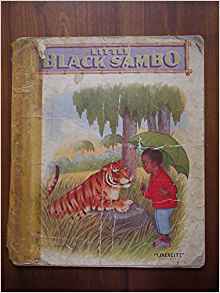-
Little Black Sambo by Helen Bannerman
Helen Bannerman
Hardcover (Ragged Bears, Jan. 1, 1744)None
-
Little Black Sambo: Colored Illustrations
Helen Bannerman
Paperback (CreateSpace Independent Publishing Platform, March 14, 2017)Little Black Sambo by HELEN BANNERMAN
-
Little Black Sambo
Helen] (ill Mary LaFetra Russell) [Bannerman
Paperback (Sam'l Gabriel, Sept. 3, 1948)None
-
Little Black Sambo
Helen Bannerman, T. Izawa & S. Hijikata
Hardcover (Crown Publishers, Inc., Jan. 1, 1962)Board picture pages. Manufactured in Japan.
-
Little Black Mingo & Little Black Sambo
Helen Bannerman
Paperback (Start Publishing LLC, June 4, 2017)These two children's books were part of a series of small-format books called The Dumpy Books for Children. They were children's favorites for more than half a century.
-
Little Black Sambo
Helen Bannerman, Fern Bisel Peat
Hardcover (Saalfield Publishing, Jan. 1, 1932)44 page hard cover children's book measuring eight inches by six and a half inches. The story of Little Black Sambo is told in this book but there is no date of publication.
-
Little Black Sambo
Helen Tenggren, Gustaf, Bannerman
Unknown Binding (Simon and Schuster, March 6, 1948)This belonged to my mother. It's in bad shape. I know this book is offensive to many. I am selling it in the hope that someone is interested in it as a piece of history.
-
Little Black Sambo
Clinton Hood, Helen Bannerman
Paperback (CreateSpace Independent Publishing Platform, May 3, 2014)Sambo is a South Indian boy who encounters four hungry tigers, and surrenders his colourful new clothes, shoes, and umbrella so they will not eat him. The tigers are vain and each thinks he is better dressed than the others. They chase each other around a tree until they are reduced to a pool of melted butter. Sambo then recovers his clothes and his mother makes pancakes out of the butter. T
T
-
Little Black Sambo
Helen Bannerman, Florence White Williams
Paperback (CreateSpace Independent Publishing Platform, Jan. 20, 2014)Little Black Sambo, Classic Children’s Literature, By Helen Bannerman, Illustrated By Florence White Williams, The Story of Little Black Sambo is a children's book written and illustrated by Helen Bannerman, and first published by Grant Richards in October 1899 as one in a series of small-format books called The Dumpy Books for Children. The story was a children's favorite for half a century until the word sambo was deemed a racial slur in some countries and the illustrations considered reminiscent of "darky iconography". Both text and illustrations have undergone considerable revision since. ambo is a South Indian boy who lives with his father and mother, named Black Jumbo and Black Mambo, respectively. Sambo encounters four hungry tigers, and surrenders his colourful new clothes, shoes, and umbrella so they will not eat him. The tigers are vain and each thinks he is better dressed than the others. They chase each other around a tree until they are reduced to a pool of melted butter. Sambo then recovers his clothes and his mother, Black Mambo, makes pancakes out of the butter.
-
Little Black Sambo
Helen Bannerman, Florence White Williams
Paperback (CreateSpace Independent Publishing Platform, Dec. 29, 2015)Little Black SamboBy Helen BannermanIllustratedBy Florence White WilliamsThe Story of Little Black Sambo is a children's book written and illustrated by Helen Bannerman, and first published by Grant Richards in October 1899 as one in a series of small-format books called The Dumpy Books for Children. The story was a children's favorite for more than half a century though criticism began as early as 1932. The word sambo was deemed a racial slur in some countries and the illustrations considered reminiscent of "darky iconography". Both text and illustrations have undergone considerable revision since.The book has a controversial history. The original illustrations by Bannerman showed a caricatured Southern Indian or Tamil child. The story may have contributed to the use of the word "sambo" as a racial slur. The book's success led to many pirated, inexpensive, widely available versions that incorporated popular stereotypes of "black" peoples. For example, in 1908 John R. Neill, best known for his illustration of the Oz books by L. Frank Baum, illustrated an edition of Bannerman's story. In 1932 Langston Hughes criticised Little Black Sambo as a typical "pickaninny" storybook which was hurtful to black children, and gradually the book disappeared from lists of recommended stories for children.In 1942, Saalfield Publishing Company released a version of Little Black Sambo illustrated by Ethel Hays. During the mid-20th century, however, some American editions of the story, including a 1950 audio version on Peter Pan Records, changed the title to the racially neutral Little Brave Sambo.
-
LITTLE BLACK SAMBO
HELEN BANNERMAN, FERIE BISEL PEAT
Hardcover (PRANG COMPANY PUB., Jan. 1, 1946)None
-
Little Black Sambo
Helen Bannerman, Robert Moore
Hardcover (Grosset & Dunlap, Jan. 1, 1942)This vintage hardcover book is an anthology of favorite children's stories, interspersed with Mother Goose Rhymes, traditional Fairy Tales (Henny Penny, 3 Little Pigs, Hansel & Gretel...), and a lengthy section of cautionary verses on the dangers of bad behavior ("Slovenly Peter", "Slovenly Betsy", "Phoebe Ann: Proud Girl", "The History of the Dirty Child", "Envious Minny", "The Story of Sophy Spoilall", "The Story of the Cry-Baby", "Frank, the Liar", and a quite shocking "The Dreadful Story of Pauline and the Matches" (yes, she burns to ashes!). Some truly beloved tales are here, though: Uncle Wiggily, Peter Rabbit, Reddy Fox, Black Sambo, and the Tortoise and the Hare. Illustrated thoughout with small ink illustrations, most quite charming examples of the period, some are a bit alarming (a thumb-sucker getting his thumb snipped off with some enormous scissors, for example!). This hefty book offers a glimpse into the American childhood of the 1940's.